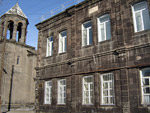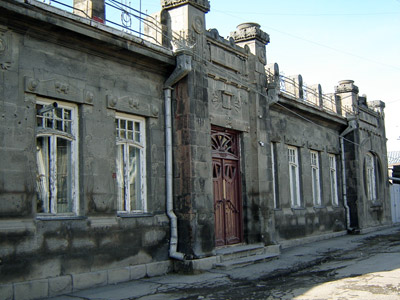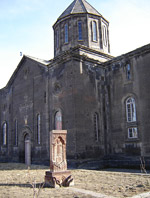
Gyumri Dairy: A Who’s Who of Aleksandrov Street
 Over the Years Locals Have Taken Pride in Their Town
At the beginning of the 20th century, Gyumri, Armenia’s second largest city, was renamed Alexandropol from 1840-1924 in honor of Czar Nicholas I's wife. Back then, the main thoroughfare and center of attraction was Aleksandrov Street, since renamed Abovyan. It stretches from the neighborhood of Slabodka to Dzori Tagh.
It was an honor and symbol of wealth for residents of Alexandropol to boast owning a house on the famed street. Well-to-do citizens always aspired to build their homes on the thoroughfare. Ghunkients Ghunki Agha, a wealthy resident of the town, built one of his many homes on the street in 1878. Later on, the building housed the municipal prosecutor’s offices. During the 1988 earthquake, part of the building collapsed.
The Drampyans – 1,000 rubles to clean the “Dirty Chai”
Levon Drampyan, a scion of another prominent Alexandropol family, owned two homes on the street. One was built in 1873 and housed the People’s Court from 1920 onwards. It had twenty-two rooms, including cellars, and its collateral value was pegged at 325,000 rubles. Drampyan owned another house at 206 Abovyan Street with twenty-five rooms. It was appraised at 52,000 rubles. The building was first allocated to “AmerKom”. It later housed Public School 4 and afterwards, a music school.
In 1898, the Drampyan brothers contributed 1,000 rubles to clean the “Dirty Chai”, a river flowing through the town. They also made charitable donations to have the wooden dome and roof of St. Astvatzatzin-Yot Verk Church (Holy Mother of God-Seven Wounds) converted to stone. One of the church council members at the time, amazed by such largesse, exclaimed, ‘May your hearth and home ever be blessed since you painfully conferred such a large donation’. (The Armenian verb is “drmpal”, hence the family name Drampyan)
There’s a famous legend connected to the Drampyan family. When the Sourb Amenaprkich Church (Holy Savior) was being built, the local clergy raised donations throughout the town for the worthy endeavor. The common folk had the impression that the wealthy members of the community were stingy and wouldn’t donate. However, when one of the priests approached the senior member of the Drampyan clan for funds, to the amazement of all, asked how much had already been raised. He then directed his wife to bring forth an equal amount. The woman came back with her apron full of money. When they told Drampyan that they had heard that the old man had hoarded money throughout his life, he replied ‘Yes, I have saved up in order to assist such endeavors’.
The first circus before the revolution was located on Aleksandrov Street. After the establishment of the Soviet Union, the first cinema, named “October”, was built there in 1926.
Hakob Rafayelyan – His Hotel Franysa later becomes city maternity ward
The first maternity ward and drugstore in the town were also opened on Abovyan Street. Built in 1873, the two-story building later housing the maternity ward belonged to Hakob Rafayelyan, a wealthy merchant. During his lifetime, it operated as the “Fransya” hotel.
Over the Years Locals Have Taken Pride in Their Town
At the beginning of the 20th century, Gyumri, Armenia’s second largest city, was renamed Alexandropol from 1840-1924 in honor of Czar Nicholas I's wife. Back then, the main thoroughfare and center of attraction was Aleksandrov Street, since renamed Abovyan. It stretches from the neighborhood of Slabodka to Dzori Tagh.
It was an honor and symbol of wealth for residents of Alexandropol to boast owning a house on the famed street. Well-to-do citizens always aspired to build their homes on the thoroughfare. Ghunkients Ghunki Agha, a wealthy resident of the town, built one of his many homes on the street in 1878. Later on, the building housed the municipal prosecutor’s offices. During the 1988 earthquake, part of the building collapsed.
The Drampyans – 1,000 rubles to clean the “Dirty Chai”
Levon Drampyan, a scion of another prominent Alexandropol family, owned two homes on the street. One was built in 1873 and housed the People’s Court from 1920 onwards. It had twenty-two rooms, including cellars, and its collateral value was pegged at 325,000 rubles. Drampyan owned another house at 206 Abovyan Street with twenty-five rooms. It was appraised at 52,000 rubles. The building was first allocated to “AmerKom”. It later housed Public School 4 and afterwards, a music school.
In 1898, the Drampyan brothers contributed 1,000 rubles to clean the “Dirty Chai”, a river flowing through the town. They also made charitable donations to have the wooden dome and roof of St. Astvatzatzin-Yot Verk Church (Holy Mother of God-Seven Wounds) converted to stone. One of the church council members at the time, amazed by such largesse, exclaimed, ‘May your hearth and home ever be blessed since you painfully conferred such a large donation’. (The Armenian verb is “drmpal”, hence the family name Drampyan)
There’s a famous legend connected to the Drampyan family. When the Sourb Amenaprkich Church (Holy Savior) was being built, the local clergy raised donations throughout the town for the worthy endeavor. The common folk had the impression that the wealthy members of the community were stingy and wouldn’t donate. However, when one of the priests approached the senior member of the Drampyan clan for funds, to the amazement of all, asked how much had already been raised. He then directed his wife to bring forth an equal amount. The woman came back with her apron full of money. When they told Drampyan that they had heard that the old man had hoarded money throughout his life, he replied ‘Yes, I have saved up in order to assist such endeavors’.
The first circus before the revolution was located on Aleksandrov Street. After the establishment of the Soviet Union, the first cinema, named “October”, was built there in 1926.
Hakob Rafayelyan – His Hotel Franysa later becomes city maternity ward
The first maternity ward and drugstore in the town were also opened on Abovyan Street. Built in 1873, the two-story building later housing the maternity ward belonged to Hakob Rafayelyan, a wealthy merchant. During his lifetime, it operated as the “Fransya” hotel.
 The building that housed the drugstore was built in 1870 by another prominent merchant, Khachatour Khalatov. It remains a drugstore till today
Private homes on Aleksandrov Street were also built by Doctor Mkhitaryan, the Charkhchyan brothers, Geghamovents and Ara Abadjyan.
The building that housed the drugstore was built in 1870 by another prominent merchant, Khachatour Khalatov. It remains a drugstore till today
Private homes on Aleksandrov Street were also built by Doctor Mkhitaryan, the Charkhchyan brothers, Geghamovents and Ara Abadjyan.
 The famous composers Nikoghayos Tigranyan and Armen Tigranyan also lived on Aleksandrov Street.
When Rafayelyan built his magnificent house, the father of Nikoghayos Tigranyan casually asked what he was up to. “I am decorating the façade of the house,” answered Rafayelyan. “You go ahead and decorate your house and I’ll do the same to my boy’s heads. We’ll see who’s right," countered Tigranyan. In time, the two were proved correct. Both the magnificent home of the Rafayelyans and the art of the Tigranyans have been preserved for future generations to enjoy.
St. Amenaprkich and St. Nshan Churches Adorn Abovyan Street
The famous composers Nikoghayos Tigranyan and Armen Tigranyan also lived on Aleksandrov Street.
When Rafayelyan built his magnificent house, the father of Nikoghayos Tigranyan casually asked what he was up to. “I am decorating the façade of the house,” answered Rafayelyan. “You go ahead and decorate your house and I’ll do the same to my boy’s heads. We’ll see who’s right," countered Tigranyan. In time, the two were proved correct. Both the magnificent home of the Rafayelyans and the art of the Tigranyans have been preserved for future generations to enjoy.
St. Amenaprkich and St. Nshan Churches Adorn Abovyan Street
 Two prominent churches in Alexandropol are located on Abovyan Street; St. Amenaprkich and St. Nishan. St. Nishan also called the “Sev Zham” (Black Church) was built in 1870 under the direction of Vardapet Ananikyan. It was repaired after being damaged in the 1988 earthquake and now serves the spiritual needs of the community. At one point, the Sahakanoush School for Young Ladies operated next to the church.
Work on St. Amenaprkich began in 1852 and lasted till 1873. Local residents of Gyumri also had a hand in the construction. Construction funds were raised by the people. It was a man named Manouk, a local carpenter, who carved and placed the cross atop the church’s dome. In praise of his contribution, the townsfolk nicknamed him “Ardar Manouk” (Righteous Manouk). Tadevos Andikyan was responsible for most of the ornamental work in the church.
An all male parish school also operated next to the church from the 1840’s on. During the Soviet era, the school was used as a symphony space.
St. Amenaprkich was heavily damaged as a result of the 1988 earthquake and is now undergoing repairs. The initial funds for the repair work were donated by the residents of Gyumri, just as they did back when the church was first built.
Bath houses, arts and crafts and a candy factory
Other notable educational institutions located on Abovyan Street were the “gymnasium” (academic secondary school) located in the building housing the gallery of the Aslamazyan sisters and the Abadjyan private school. Famed pedagogue Ara Abadjyan, the author of many textbooks, devoted his life to educational affairs and converted his house into a school.
There were also a number of public bath houses built in the center of town. The bath house located on Abovyan Street was previously called the “Central” and was owned by Ter-Martirosyan. The street also featured the bath house belonging to Gevor Agha.
The street also housed numerous crafts and trades stalls and commercial houses. Notable examples were the store owned by “Kyastanents” Martin, the store of “Djermak” Hamo and the “Kantiterski” of the Yeranosov family. The delectable scents emanating from this candy factory filled the entire street.
There was a horse drawn carriage stop here as well. The “Godorsky Club” operated in the building housing the wedding hall and military and classical music concerts were held there as well as dance receptions. It was also used as testimonial hall and sessions of the Duma took place there.
Aleksandrov Street was also noteworthy as a favorite promenade for locals and young sweethearts. A familiar expression amongst residents was “Ertank var” (Let’s go down); meaning down to Aleksandrov.
A Tale from the Annals of “Poloz Moukuch”
“Poloz Moukuch” (Beanpole Moukuch), Gyumri’s most famous and much-loved humorist was known far and wide for lambasting the town and its inhabitants. Born into a family of silversmiths, he never learnt the trade, instead becoming a “podriatchik” (middleman) who sold produce from a horse-drawn cart. He died in 1931 and hundreds of Gyumri residents attended his funeral, drinking to his memory and leaving the empty bottles in his grave.
During 1910-1920, Gyumri Mayor Garegin Levonyan directed that telephone lines be installed for several municipal office buildings. The work began at the “Cheka” (Secret Service).
Poloz Moukuch stands to one side watching the street being dug up to install the cable. Not able to contain his curiosity and growing alarm he approaches the foreman.
- Tzo, Why are you guys ripping up the pavement?
- We’re installing a wireless telephone, answers the foreman in jest and adds, Now, the residents of Gyumri can talk to each other from far and wide.
- How much is this costing? Moukuch asks.
- About 50,000-80,000, replies the foreman.
- Tzo, Come to your senses man, Moukuch replied in anger, Instead of spending all that money You should just round up three stout women with wagging tongues who like to gossip. Place The first at the entrance to the cemetery, the second at the door outside Djermak Hamo’s store. And the third by the Yerkar Hako fountain. Believe you me, in just two hours these three
Women will have filled the town with enough news to last a lifetime.
(“Tzo” – an exclamation in the Gyumri dialect equivalent to “Hey man”; akin to the “Ara” heard today on Yerevan streets)
Two prominent churches in Alexandropol are located on Abovyan Street; St. Amenaprkich and St. Nishan. St. Nishan also called the “Sev Zham” (Black Church) was built in 1870 under the direction of Vardapet Ananikyan. It was repaired after being damaged in the 1988 earthquake and now serves the spiritual needs of the community. At one point, the Sahakanoush School for Young Ladies operated next to the church.
Work on St. Amenaprkich began in 1852 and lasted till 1873. Local residents of Gyumri also had a hand in the construction. Construction funds were raised by the people. It was a man named Manouk, a local carpenter, who carved and placed the cross atop the church’s dome. In praise of his contribution, the townsfolk nicknamed him “Ardar Manouk” (Righteous Manouk). Tadevos Andikyan was responsible for most of the ornamental work in the church.
An all male parish school also operated next to the church from the 1840’s on. During the Soviet era, the school was used as a symphony space.
St. Amenaprkich was heavily damaged as a result of the 1988 earthquake and is now undergoing repairs. The initial funds for the repair work were donated by the residents of Gyumri, just as they did back when the church was first built.
Bath houses, arts and crafts and a candy factory
Other notable educational institutions located on Abovyan Street were the “gymnasium” (academic secondary school) located in the building housing the gallery of the Aslamazyan sisters and the Abadjyan private school. Famed pedagogue Ara Abadjyan, the author of many textbooks, devoted his life to educational affairs and converted his house into a school.
There were also a number of public bath houses built in the center of town. The bath house located on Abovyan Street was previously called the “Central” and was owned by Ter-Martirosyan. The street also featured the bath house belonging to Gevor Agha.
The street also housed numerous crafts and trades stalls and commercial houses. Notable examples were the store owned by “Kyastanents” Martin, the store of “Djermak” Hamo and the “Kantiterski” of the Yeranosov family. The delectable scents emanating from this candy factory filled the entire street.
There was a horse drawn carriage stop here as well. The “Godorsky Club” operated in the building housing the wedding hall and military and classical music concerts were held there as well as dance receptions. It was also used as testimonial hall and sessions of the Duma took place there.
Aleksandrov Street was also noteworthy as a favorite promenade for locals and young sweethearts. A familiar expression amongst residents was “Ertank var” (Let’s go down); meaning down to Aleksandrov.
A Tale from the Annals of “Poloz Moukuch”
“Poloz Moukuch” (Beanpole Moukuch), Gyumri’s most famous and much-loved humorist was known far and wide for lambasting the town and its inhabitants. Born into a family of silversmiths, he never learnt the trade, instead becoming a “podriatchik” (middleman) who sold produce from a horse-drawn cart. He died in 1931 and hundreds of Gyumri residents attended his funeral, drinking to his memory and leaving the empty bottles in his grave.
During 1910-1920, Gyumri Mayor Garegin Levonyan directed that telephone lines be installed for several municipal office buildings. The work began at the “Cheka” (Secret Service).
Poloz Moukuch stands to one side watching the street being dug up to install the cable. Not able to contain his curiosity and growing alarm he approaches the foreman.
- Tzo, Why are you guys ripping up the pavement?
- We’re installing a wireless telephone, answers the foreman in jest and adds, Now, the residents of Gyumri can talk to each other from far and wide.
- How much is this costing? Moukuch asks.
- About 50,000-80,000, replies the foreman.
- Tzo, Come to your senses man, Moukuch replied in anger, Instead of spending all that money You should just round up three stout women with wagging tongues who like to gossip. Place The first at the entrance to the cemetery, the second at the door outside Djermak Hamo’s store. And the third by the Yerkar Hako fountain. Believe you me, in just two hours these three
Women will have filled the town with enough news to last a lifetime.
(“Tzo” – an exclamation in the Gyumri dialect equivalent to “Hey man”; akin to the “Ara” heard today on Yerevan streets)
If you found a typo you can notify us by selecting the text area and pressing CTRL+Enter
 Videos
Videos Photos
Photos
Write a comment